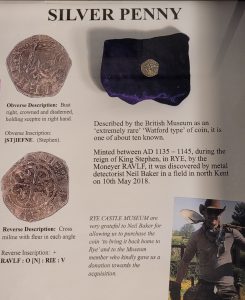This is the first in a series of articles in which people involved with the Rye Castle Museum choose an object from the collection that represents an aspect of the history of the town, and its environs, and tell us what it means to them.
The Rye King Stephen silver coin chosen by former history and geography teacher, historian, Rye town councillor, former mayor and JP, and chair of the Rye Museum, Jo Kirkham MBE.

When Jo Kirkham was asked what her chosen object for the series would be she said, without any hesitation, that it would be the King Stephen silver penny displayed in East Street.
The tiny, thin coin was found by a metal detectorist Neil Baker in a Kent churchyard on May 10, 2018. He took it to the Portable Antiquities officer for Kent who sent it to the British Museum for authentication and evaluation. It was described by them as an extremely rare penny, one of only about 10 known. With the help of a donation from a Rye Museum member, the penny was acquired by the museum in 2019 and is now proudly displayed in a special British Museum coin cabinet in East Street. As Neil Baker put it, it is “back home to Rye”.
Medieval coins
In the 12th century, monarchs took the minting of coins very seriously and tightly controlled their design, metal content and weight. Coins were minted by individual moneyers across England. They were minted by hand on blank metal sheets onto which the design was imprinted by hammering, then the coin was trimmed into its circular shape. Moneyers paid the monarch fees to strike coinage and for the dies used to hammer out the designs. The inscription on the coins included the towns where they worked and the name of the moneyers.

What makes the Rye Museum coin so special is that it was minted between 1136 and 1145 for King Stephen of England by moneyer, Raulf (Ravlf) in Rye (Rie) as seen on the inscription.
On one side is bust crowned and diademed holding a sceptre in right hand with the inscription [ST]IEFNE or Stephen. On the back is a cross moline with fleur on each angle and inscribed RAVLF: O [N]: RIE:V
King Stephen and the Anarchy
King Stephen, the grandson of William I, claimed the throne after the death of his uncle, Henry I (in 1135) whose only son and heir had drowned in 1120. Henry had wanted his daughter, Matilda, to succeed him but while she was in Normandy, Stephen (her cousin) supported by many of the barons, seized the throne. This led to nearly 20 years of civil war between the supporters of Matilda and Stephen, known as the Anarchy (1138-1154). Stephen’s strongholds were London and the south east including Sussex. The rivalry between Stephen and Matilda continued until Stephen agreed that Matilda’s son, Henry would become king on Stephen’s death. As a result, in 1154, Henry II became king.
Rye’s moneyers and mint
It is known that there was a mint in Rye before King Stephen as coins from Rye have been found dated 1115. Very little is known about Raulf or where he minted the Rye coins because in 1377 a French attack destroyed nearly all the town apart from the St Mary’s church and a few stone buildings including the Landgate, Ypres tower and Friars of the Sack. What we do know is that there was not a mint in Rye on the street now known as the Mint, which is in fact a Victorian naming.
Jo Kirkham says: “I have always known that Rye had a mint and we knew that there were certain coins, only one or two that had been minted in Rye. It was wonderful, absolutely wonderful holding the penny for the first time – it’s so small and very thin. But when you think that it was actually minted in 1135 or 6! We know of three moneyers who made coins in Rye and it was obviously a productive mint for the borough of Rye at that time.”
There is much to discover in both the East Street site and Ypres Tower. In future articles in this series, we will cover many of the important aspects of Rye history including shipbuilding, Rye Pottery, smuggling, glassware production and many others.
Ryecast talks to Jo Kirkham
Listen to this week’s Ryecast, in which James Stewart talks to Jo Kirkham about the museum, her favourite object, and her many roles in the town over more than 50 years.
Also in this episode, I tell James about my favourite object: the painting of Rye attributed to Hendrik Danckaertz, (originally dated 1630-1679 but more recently dated as 1720-42) which can be seen in East Street, and the story of my family connection to it.

The painting shows the town of Rye as seen from Rye Hill with the sea, ships, Camber Castle and Winchelsea hill in the distance. It shows clearly, how Rye was once an island with the sea coming right up to surround the town on three sides and covering the land around, up to Cadborough Cliff, Winchelsea and the causeway to Rye Hill. The town itself is a jumble of red roofs, smoking chimneys and recognisable buildings – St Mary’s Church, the Landgate and Ypres tower.
The Rye Castle Museum has two sites, one in a former bottling factory in East Street and the other the castle, Ypres Tower.
Ypres Tower is open daily throughout the year. March 30 – October 31 from 10:30am to 5pm. November 1 – March 29 from 10:30am to 3:30pm.
East Street is open at weekends from April to October from 10:30am to 4:40pm (subject to availability of volunteers).
Image Credits: Kent County Council , Juliet Duff , Rye Castle Museum .




Terrific series. More, please!